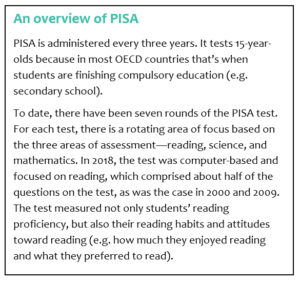What’s in a test? Making sense of the latest PISA scores
Canadian 15-year-olds scored in the top ten in international tests of reading, mathematics and science last year, but what does that really mean – for our students, and for education in Canada?
The results of the tests were released at the end of last year by the Organisation for Economic Cooperation and Development (OECD) and are taken from their 2018 Programme for International Student Assessment (PISA). PISA measures 15-year-olds’ abilities in reading, mathematics, and science around the world. In total, 79 countries and economies—including Canada—participated in PISA in 2018 which sampled over 600,000 students.
Since PISA was launched in 2000, the purpose and meaning of the results have been contentious among education leaders and scholars.
The OECD and supporters of the test have identified PISA as being “the world’s most comprehensive and reliable indicator of what students are capable of doing.” On the other hand, in 2014, over 100 leaders in education around the world, wrote a letter to the director of the PISA, Andreas Schleicher, urging a pause on PISA. In spite of this, the test was not cancelled for 2015 or 2018 cycles.
Are you smarter than a 10th grader? Click here for sample questions from the 2018 PISA test.
How did Canada do?
Canadian students are some of the highest performers in the world on the PISA test. In all three areas—reading, mathematics, and science—Canada achieved above the average of the participating OECD countries and was one of the top 10 countries and economies across reading, mathematics, and science.
This level of achievement does not come as a surprise. Canada has been one of the highest performers on international tests for years. For instance, high reading scores have remained stable in Canada since 2009. Canada has also been recognized for its high level of equity. The Council of Ministers of Education, Canada (CMEC) reported, “Canadian immigrant students performed as well as non-immigrant while second-generation immigrant students obtained higher scores than non-immigrant students.”
The graph shows how strongly Canadian students (and, specifically, Ontario’s students) performed compared to the OECD average, which included results from 37 countries including Australia, Germany, and the United Kingdom. Specifically, the graph outlines the percentage of students who performed above the baseline level of proficient on last year’s PISA test.

Percentage (%) of students performing above the baseline level of proficiency on the 2018 PISA test
In spite of this ‘good news’ story, Canada has room to grow in all three subject areas. The PISA results highlight that there is a still a gap in the achievement between boys and girls: girls outperforming boys in reading and boys outperforming girls in math. Also, although Canadian students, on average, are achieving over the baseline level of reading proficiency, one in seven Canadian students scored at the lowest levels. In addition, the overall scores have declined over the last 8 years. Canadian students scored 534 overall in reading in the inaugural PISA test in 2000 but achieved 520 on the 2018 test – a difference of 14 points.
Everybody has gone down in reading, all OECD countries have gone down since 2000 in reading. Canada still has maintained its level, but it has gone down. – Caroline Alphonso, The Agenda
PISA: A double-edged sword
Caution is warranted when looking at high-level results from standardized tests, such as PISA. Experts have warned that PISA only provides a snapshot of how students are doing in those areas and can have a series of unintended negative consequences, including: an over-reliance on quantitative measures, a focus on short-term fixes to climb in the rankings, attention on only what can be ‘measured’ (e.g. the 3R’s), and promoting anxiety and stress for students.
Given the complexity of this conversation, multiple perspectives should be considered.
Here are what some key stakeholders are saying:
First, there is no evidence to justify, let alone prove, the claim that PISA indeed measures skills that are essential for life in modern economies. Second, the claim is an imposition of a monolithic and West-centric view of societies on the rest of the world. Third, the claim distorts the purpose of education. Young Zhao, a Foundation Distinguished Professor in the School of Education at the University of Kansas in The Washington Post
without this kind of data, there would be no way to know where to focus change.” Kathryn O’Grady, Coordinator of Learning Assessment Programs, Council of Ministers of Education, Canada (CMEC)
PISA is not only the world’s most comprehensive and reliable indicator of students’ capabilities, it is also a powerful tool that countries and economies can use to fine-tune their education policies.” Angel Gurría, secretary-general of the OECD
…rather than suggesting haphazard, simple solutions to improve student learning, we should consider PISA as evidence for the following next steps: make equity in education the highest priority. PISA 2018 shows again that the most successful education systems are those that invest equally in equity and excellence…Give teaching, not testing, the highest priority. Pasi Sahlberg, Professor of Education Policy at the Gonski Institute for Education at the University of New South Wales
